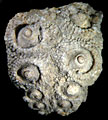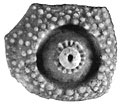The Echinoid Directory
Couvelardicidaris Vadet, 1991, p. 97
| Diagnostic Features |
|
|---|---|
| Distribution | Lower to Middle Jurassic (Pliensbachian- Bajocian) western Europe. |
| Name gender | feminine |
| Type | Cidaris moorei Cotteau, 1875, p. 24, by original designation. |
| Species Included |
|
| Classification and/or Status |
|
| Remarks |
|


